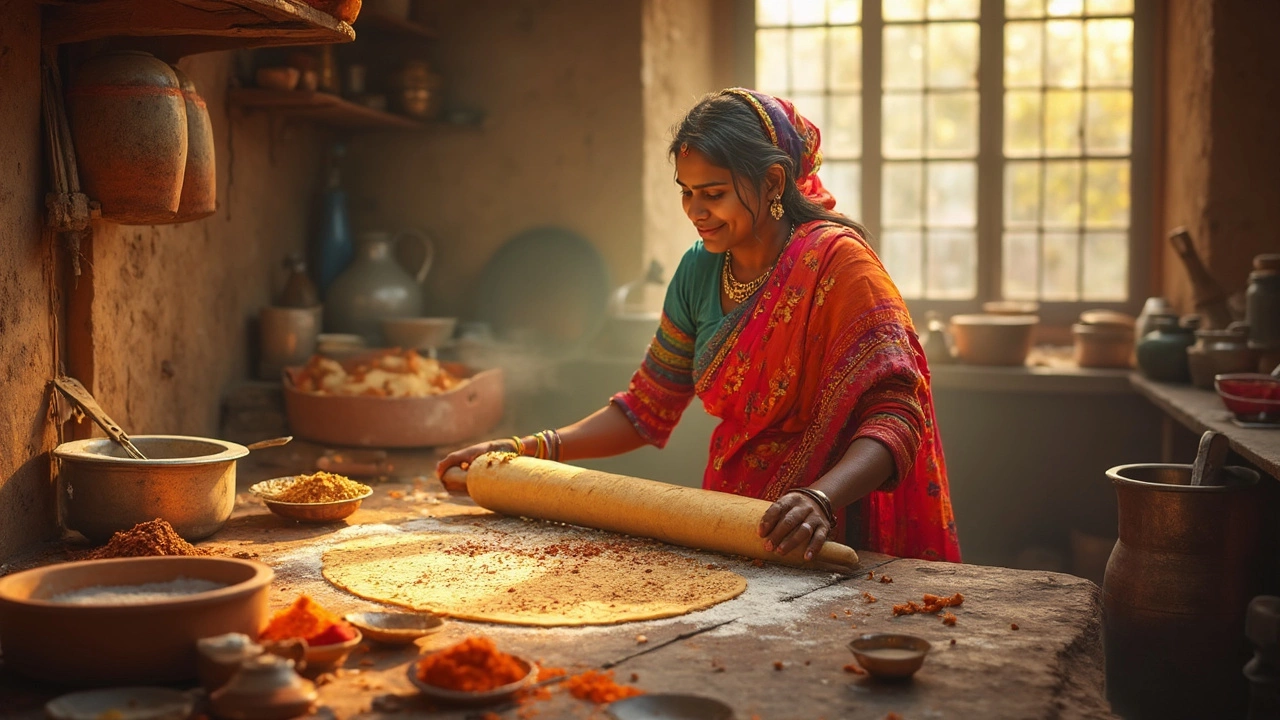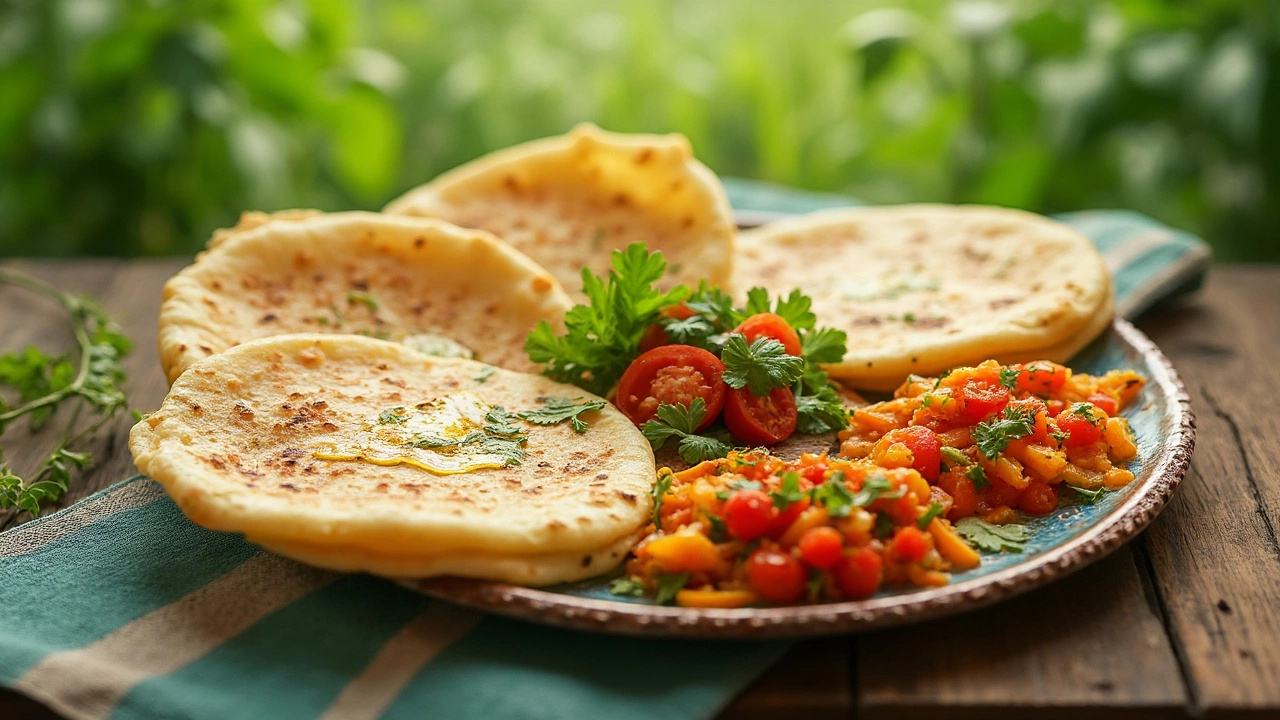Roti Macros: Calories, Protein, and Fiber Demystified
 Feb, 18 2025
Feb, 18 2025
When it comes to roti, it's not just about the taste. Knowing what's in your roti can help you better align your diet with your health goals. So, how much calories in 1 roti? Typically, a medium-sized whole wheat roti contains about 70-80 calories. But there's more to it—protein and fiber in roti play vital roles too.
If you’re pondering over a meal with roti and sabzi, the calorie count is going to change. For those who enjoy a slather of ghee on their roti, expect the calorie count to bump up slightly, adding richness and flavor but also fat.
Figuring out how many calories in 1 roti isn't too tricky, but it helps to consider how it's prepared and what you pair it with. Let’s unravel the details, shall we?
- The Basics of Roti Nutrition
- Calories in 1 Roti
- Roti with Sabzi: A Nutritional Breakdown
- Impact of Adding Ghee to Roti
- Balancing Roti in Your Diet
The Basics of Roti Nutrition
Understanding what's inside a roti isn't just for nutrition nerds—it's useful for anyone looking to eat smarter! Roti, a staple in many households, carries its nutritional weight. Knowing exactly calories in 1 roti can help you make better dietary decisions.
Key Nutrients in Roti
A single whole wheat roti typically boasts around 70-80 calories. But that's not all. It's also packed with:
- Protein: A roti usually has 2-3 grams of protein, ideal for tissue repair and maintaining muscle mass.
- Fiber: Each roti contains about 2 grams of fiber, promoting good digestion and helping to keep you feeling full.
- Carbohydrates: With roughly 15-20 grams of carbs, it provides your body with much-needed energy.
The Problem with Portions
If you're having more than one roti, those calories and carbs add up fast. It's essential to consider your portions, especially if you're pairing them with rich curries or extra condiments. Underestimating how many calories in 1 roti can lead to consuming more than you planned!
Solution: Balancing Your Meal
Start by serving your roti with a side of vegetables or lean protein. Here's how you can structure a balanced meal:
- Identify your portion: Stick to 1-2 rotis per meal depending on your calorie needs.
- Pair with proteins: Add a portion of dal or grilled chicken to keep protein intake high.
- Load on veggies: Include a colorful salad or cooked veggies to boost vitamins and fiber.
By considering these factors, you can enjoy your favorite meal while maintaining your health goals!
Calories in 1 Roti
Let's get to the bottom of the big question: how many calories in 1 roti? A plain, homemade whole wheat roti usually contains about 70 to 80 calories. But keep in mind, this number can shift slightly depending on the size and thickness. You may wonder why this matters—all those little calories can add up, especially if you're enjoying multiple rotis at each meal.
Understanding Roti Ingredients
The main ingredients are whole wheat flour and water, but their proportions can influence the calorie count. To keep it at the lower end of the calorie scale, aim for a thin, evenly rolled roti.
- Whole wheat flour: Rich in fiber and better for digestion.
- Water: Used to make the dough.
- Oil (optional): Some add a teaspoon to the dough for softness, which can bump up the calorie count.
How Preparation Affects Calories
If you're keen to manage your calorie intake, pay attention to how you cook your rotis. While traditional pan roasting on a tawa is the norm, using additional fats or oils during cooking will increase calories.
Here's a tip: try cooking your roti on a well-heated tawa to avoid sticking, reducing the need for extra oil.
Problem and Solution: Calorie Control
Struggling with keeping those calories in check? One way is to focus on portion control—be aware of how much calories in 1 roti add up over the course of a meal. Pairing your roti with low-calorie, high-fiber vegetables can help ensure you're still satisfied without tipping the calorie scales.

Roti with Sabzi: A Nutritional Breakdown
Pairing your roti with sabzi can make it a wholesome meal. But ever wondered what this pairing brings to your plate in terms of nutrition? Let’s break it down so you can enjoy your meal to the fullest while being health-conscious.
Why Choose Sabzi with Your Roti?
First up, adding sabzi means you're upping the nutrient ante. Vegetables are packed with vitamins, minerals, and fiber that help in digestion and keep you feeling full for longer.
Here's a quick guide on turning your calories in 1 roti and sabzi into a meal that suits your health needs:
- Balance the Plate: Aim for a portion where roti forms the base, around 1-2 medium-sized rotis, and fill half the plate with sabzi.
- Variety is Key: Mix and match different vegetables like spinach, carrots, and bell peppers. This keeps the meal exciting and colorful.
- Cooking Methods Matter: Try steaming or stir-frying instead of deep-frying your vegetables. This keeps the calorie count in check.
Calorie Count with Roti and Sabzi
Let’s talk numbers. On average, adding a generous serving of sabzi (one cup) to your roti contributes about 150 calories, depending on the ingredients and cooking style.
| Food Item | Calories |
|---|---|
| 1 Roti | 70-80 |
| 1 Cup Sabzi | 150 |
That's roughly 220-230 calories for a simple yet nourishing meal of roti and sabzi.
How to Maximize Nutrition
To ensure you're getting the most out of your meal, try these steps:
- Include Lentils: Add some lentils to your sabzi for an extra protein boost, making the meal more satisfying.
- Spice Wisely: Use spices like turmeric and cumin, which are known for their health benefits without adding extra calories.
- Watch the Oil: Keep a check on the amount of oil while cooking. A teaspoon should suffice for most vegetable stir-fries.
By approaching your meal with this understanding, you can enjoy your roti with sabzi knowing you're making a nutritious choice. Remember, little changes make a big difference!
Impact of Adding Ghee to Roti
Adding ghee to your roti can transform a simple flatbread into something a bit richer and more flavorful. But what does it mean for the nutritional profile? Let's dig in.
What Changes with Ghee?
When you add a spoonful of ghee to your roti, it increases the calorie content by about 45 calories per teaspoon. Roti with ghee tends to have higher fat content, given that ghee is essentially clarified butter. While this may sound intimidating, it can be beneficial in moderation.
Ghee is known for its healthy fats which support brain health, boost energy, and contain fat-soluble vitamins like A, D, E, and K. So, isn't that something worth considering?
Balancing Ghee in Your Diet
The challenge is ensuring the added calories don't lead to unwanted weight gain. Here's how to keep ghee addition in check:
- Portion Control: Use a small amount of ghee, like half a teaspoon, to enjoy its flavor without overloading on calories.
- Pair Wisely: Complement your roti with ghee with light vegetable dishes to balance the meal.
- Mind Your Dietary Goals: If you're focusing on weight management, factor the calories from ghee into your daily intake plan.
Adding ghee can be a boon if done thoughtfully, enhancing both flavor and nutrition.
Understanding Ghee's Role
Think of ghee not just as an addition to be cautious of but also a traditional dietary staple that has its own set of benefits. Here's a snapshot:
| Nutrient | Per Teaspoon of Ghee |
|---|---|
| Calories | 45 |
| Healthy Fats | 5g |
So if you ask yourself once more, "How many calories in 1 roti with ghee?" – be ready, it's a richer experience, but one to relish mindfully!

Balancing Roti in Your Diet
Finding the right balance with your roti consumption can be tricky, but it’s key to better health and fitness.
Understanding Your Nutritional Needs
Start by getting a grip on your daily calorie and nutrient requirements. Are you looking to lose weight, gain muscle, or just maintain your current health? Knowing your goals is the first step. Calories in 1 roti vary mostly by size and what you add to it, like ghee or if paired with sabzi.
Portion Control and Pairing
Eating one or two rotis with a balance of veggies or protein like dal can provide a filling meal without going overboard on calories. Remember, calories in 1 roti with ghee will be higher, so if you're watching your fat intake, you might skip or reduce the ghee.
Make the Most of Roti's Nutrients
Roti is already a good source of carbs and fiber, but you can boost its nutritional benefits. Consider using multigrain flour or adding seeds like flax for more fiber.
Planning Your Meals
While enjoying roti at meals, focus on what else you’re eating. Are you getting enough protein and healthy fats? A balanced plate includes all these macronutrients. Let’s look at a quick plan:
- Start your day with a protein-rich breakfast, maybe an omelette.
- For lunch, pair roti with greens or lean meat.
- At dinner, go for a light sabzi with a roti to keep it easy on your stomach.
Consider this strategy part of your daily routine to help manage your weight and health while enjoying your favorite meals. Balancing doesn't mean compromising!